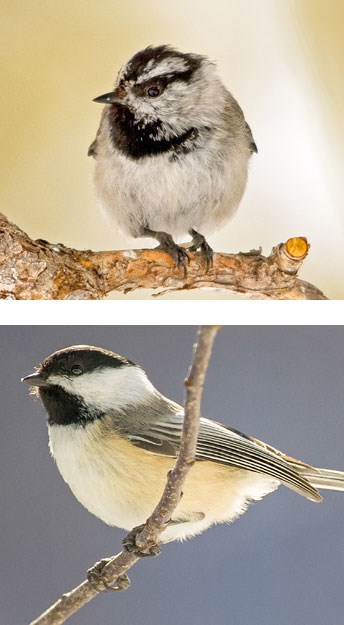
NPS 
Bottom: Black-capped Chickadees do not have a white band above the eyes. NPS Poecile gambeliLength: 4.3-5.5 in (11-14 cm) - Weight: 0.4 oz (11 g) General DescriptionMountain Chickadees look similarto Black-capped Chickadees, with black caps, white cheeks, and black throats. They are gray above with light gray to buff sides and underparts. However, they have distinctive white lines above each eye, slightly longer bills, and are grayer underneath than Black-capped Chickadees. Males, females, and juveniles share the same plumage. HabitatMountain Chickadees are typically found in dry coniferous forests. Common across most of the evergreen forests of Western mountains, particularly pine, mixed conifer, spruce-fir, and pinyon-juniper forests. Mountain Chickadees use conifers heavily, typically leaving deciduous stands to the Black-capped Chickadee. The exception is in nesting, when Mountain Chickadees will seek out any available aspen trees for their soft, easily excavated wood. During the summer they can also be found in high-elevation aspen forests. In winter, they sometimes inhabit juniper stands and river bottoms. BehaviorMountain Chickadees are active and acrobatic, clinging to small limbs and twigs or hanging upside down from pine cones. In summer, they band together into groups of up to three pairs of adults plus a variety of young birds. In winter, Mountain Chickadees flock with kinglets and nuthatches, with birds following each other one by one from tree to tree. Mountain Chickadees often hang upside-down to get at the undersides of branches, cones, and needles. They will occasionally hover and will come to seed and suet feeders. They store food in the fall and retrieve it later in winter. On cold, sunny mornings, Mountain Chickadees catch a little extra warmth by "sunbathing" on an exposed perch out of the wind. Unlike some other species, they typically brave the cold winter nights alone, huddled in foliage clumps or under big flakes of bark. DietMountain Chickadees eat protein-rich insects and spidersduring warm months, supplementing them with seeds and nuts as available. They come to bird feeders all year round. They eat many kinds of insects, including beetles, caterpillars, wasp larvae, aphids, and leafhoppers, as well as hard-to-reach scale insects and fly larvae hidden in plant galls. In fall and winter, seeds of montane pine species are very important. NestingMountain Chickadees nest in cavities but they can't excavate them unless the wood is very soft. Instead, they rely on holes made by other birds such as small woodpeckers and nuthatches. They also nest in natural crevices, in nest boxes, and occasionally on the ground amid roots. Mountain Chickadees are monogamous and form long-term pair bonds. Inside the cavity the female makes a neat cup from fur she gathers. She also makes a fur plug or cap that she uses to cover her eggs when she leaves the cavity. In some cases chickadees compensate for large cavities by filling them several inches deep with insulating material. Eggs & IncubationThe eggs of the mountain chickadee are generally white with no markings. The female incubates five to eight eggs for about 11-14 days. The male brings food while the female incubates, and for the first few days after the young hatch, as the female broods the young almost continuously. As the young grow, the female joins the male in providing food. The young leave the nest at about 18-21 days, but stay on the breeding territory for another two to three weeks before heading off on their own. Migration StatusMountain Chickadees are mostly permanent residents, although food shortages may induce some (especially juveniles) to move to lower elevations in winter. Interesting Facts
|
Last updated: May 4, 2018
